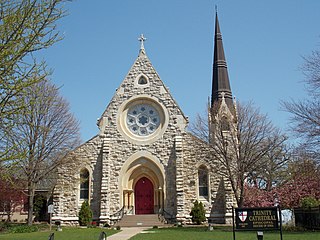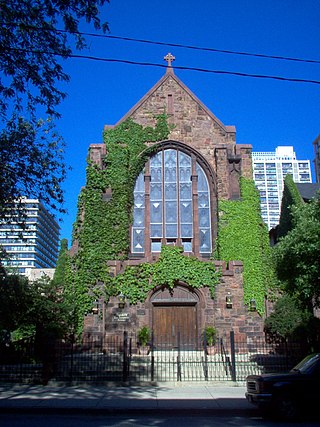
The Cathedral Church of St. Paul is the cathedral church of the Episcopal Diocese of Michigan. In 1824 its congregation formed as the first Episcopal and first Protestant church in the Michigan Territory.

St. Mary's Episcopal Church is an historic Carpenter Gothic church located at 400 St. Johns Avenue in Green Cove Springs, Florida. On February 17, 1978, it was added to the U.S. National Register of Historic Places.

St. Andrew's Episcopal Church, also known as St. Andrew's Church is a historic church building on County Highway 12 in Prairieville, Alabama. Built by slaves in 1853, it is a remarkably well-preserved example of Carpenter Gothic architecture, its design apparently taken from a book by Richard Upjohn. St. Andrew's was added to the National Register of Historic Places on November 7, 1973, and was declared a National Historic Landmark on the same day. Public access is allowed to this National Historic Landmark.

St. Luke's Episcopal Church is a historic Carpenter Gothic church, built during the 1850s at Cahaba, the first capital of Alabama from 1820 to 1826. The unknown builder closely followed plans published by architect Richard Upjohn in his 1852 book Rural Architecture.

The Church of the Epiphany, built in 1844, is an historic Episcopal church located at 1317 G Street, N.W., in Washington, D.C. It was added to the National Register of Historic Places on September 10, 1971.

St. Bartholomew's Episcopal Church is a historic church building located on Vermont Route 118 in Montgomery, Vermont in the United States. Its congregation was formed in 1821 as Union Episcopal Church. Church construction began in 1833 and was completed in 1835, when it was consecrated by the Rt. Rev. John Henry Hopkins, first bishop of the Episcopal Diocese of Vermont. In 1897 its name was changed to St. Bartholomew's Episcopal Church.

St. John's Episcopal Church is an antebellum-era church located at 2326 Woodward Avenue in Downtown Detroit, Michigan. It is the oldest church still standing on Woodward Avenue, an area once called Piety Hill for its large number of religious buildings. The church was listed on the National Register of Historic Places in 1982 and designated a Michigan State Historic Site in 1987.

The Holy Trinity Church, also known as the Church of the Holy Trinity (Episcopal) is a church located at 325 Gold Street in Juneau, Alaska. The present building was built in 2009, replacing an 1896 structure which burned on March 12, 2006.

The Episcopal Church of the Advent / St. John's Chapel is an historic Carpenter Gothic style Episcopal church building located at Franklin and Washington streets in Cape May, Cape May County, New Jersey, United States. Its board and batten siding, steep roofs, lancet windows and rose window are distinguishing features of Carpenter Gothic style architecture, although it lacks the usual belfry tower front entrance. Designed by the architect Henry Sims, it was built by Richard Soder beginning in 1865 for St. John's Chapel, a "summer chapel", which had been organized two years earlier. It was not consecrated, however, until 1871.

The Methodist Episcopal Church is a historic church and parsonage at 61 East Putnam Avenue in Greenwich, Connecticut. Built in 1868-69 for a Methodist congregation established in 1805, the church is a fine local example of Carpenter Gothic architecture, and the parsonage, built in 1872, is a good example of Italianate architecture. The property was listed on the National Register of Historic Places in 1988. The congregation is affiliated with the United Methodist Church.

Holy Trinity Episcopal Church also known as Holy Trinity Memorial Church is an historic Episcopal church building located at 38 Grand Avenue in the village of Swanton, Franklin County, Vermont. Built in 1876 and expanded in 1909-10, the church facilities include a fine example of the Carpenter Gothic in the older section, and the Late Victorian Gothic Revival in the newer section. The church was listed on the National Register of Historic Places as the Parish of the Holy Trinity in 2001. The church is an active parish in the Episcopal Diocese of Vermont; its current rector is the Rev. Reid D. Farrell.

Trinity Episcopal Cathedral, formerly known as Grace Cathedral, is the historic cathedral in the Diocese of Iowa. The cathedral is located on the bluff overlooking Downtown Davenport, Iowa, United States. Completed in 1873, Trinity is one of the oldest cathedrals in the Episcopal Church in the United States. It was individually listed on the National Register of Historic Places in 1974. In 1983 the cathedral was included as a contributing property in the College Square Historic District, which is also listed on the National Register.

The Church of Our Saviour is a historic Episcopal parish in the village of Mechanicsburg, Ohio, United States. Founded in the 1890s, it is one of the youngest congregations in the village, but its Gothic Revival-style church building that was constructed soon after the parish's creation has been named a historic site.

The St. John United Methodist Church in Shelbyville, Kentucky was a historic church located on College Street. It was built in 1896 and added to the National Register in 1984.

St. Peter's Episcopal Church is a large historic Carpenter Gothic Episcopal church building located at the corner of Division and Telegraph streets in Carson City, Nevada. Built in 1868, it is the oldest Episcopal church still in use in Nevada. On January 3, 1978, it was listed on the National Register of Historic Places.

Trinity Episcopal Church is a historic church building in Stockton, Minnesota, United States, constructed in 1859. It is now the Grace Evangelical Lutheran Church and was enlarged with a new wing in 1971. The original section was listed on the National Register of Historic Places in 1984 for having local significance in the themes of architecture and exploration/settlement. It was nominated for its well-preserved Carpenter Gothic architecture and shared importance to a community established by American-born settlers but later dominated by German immigrants.

St. John Chrysostom Church, also known as the Episcopal Church of St. John Chrysostom and the Little Red Church on the Hill, is a wooden Episcopal church built in 1852 in Delafield, Waukesha County, Wisconsin. In 1972 it was listed on the National Register of Historic Places.

The Episcopal Church of the Atonement and Parish House is a historic church building at 5751 North Kenmore Avenue in Chicago, Illinois. The Gothic Revival building was constructed in 1889 and added to the National Register of Historic Places in 2009.

Grace Episcopal Church is a Gothic Revival-style church started in 1855 on the Capitol Square in Madison, Wisconsin by the oldest congregation in the city. In 1976 the building was added to the National Register of Historic Places.

The Methodist Episcopal Church, also known as the Methodist Episcopal Church of Hibernia, is a historic church built in 1869 and located at 419 Green Pond Road in the Hibernia section of Rockaway Township, Morris County, New Jersey. It was added to the National Register of Historic Places on July 14, 2011, for its significance in architecture and industry. Since 1970, the building has been used as a branch of the Rockaway Township Free Public Library.




















